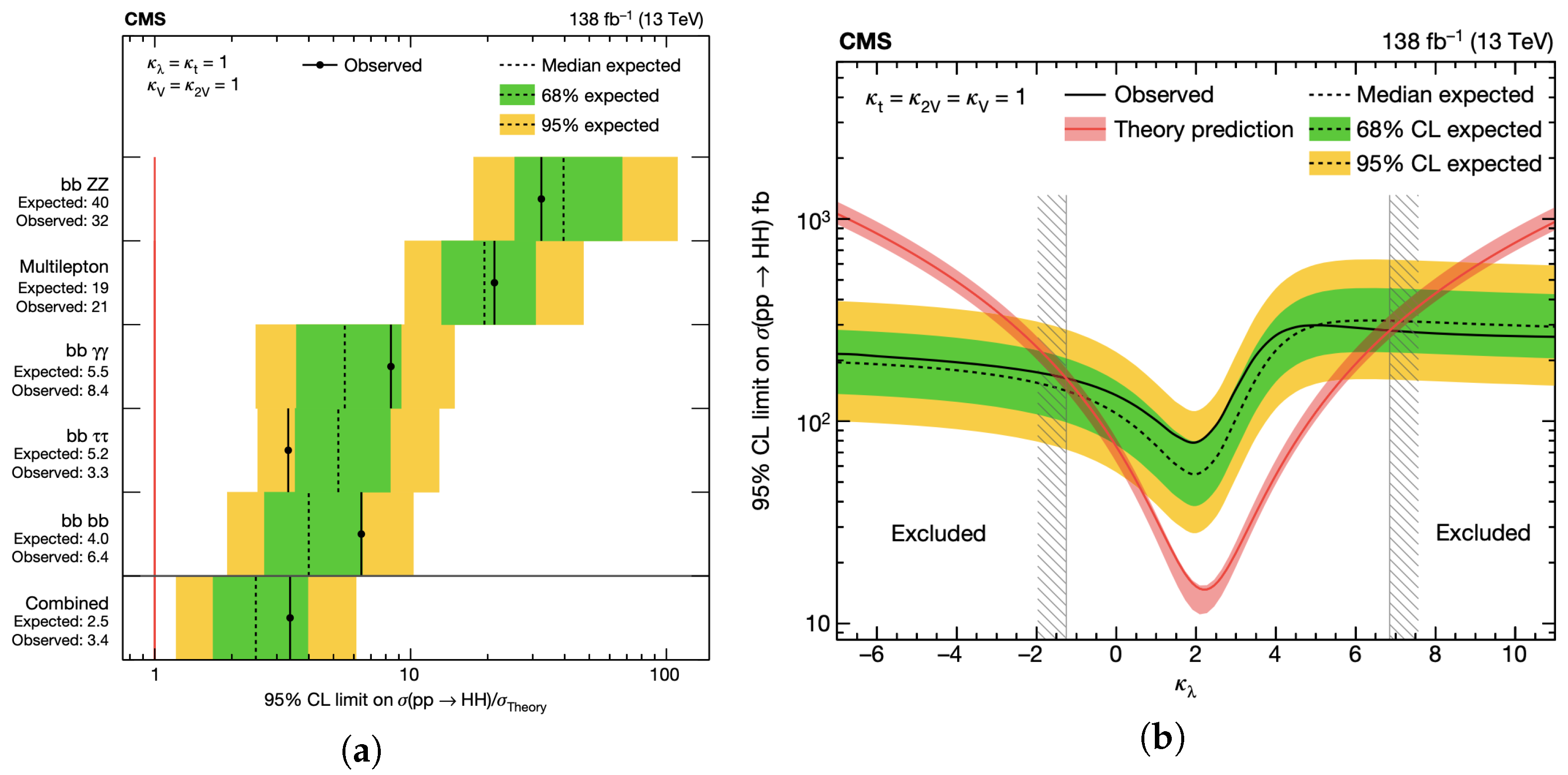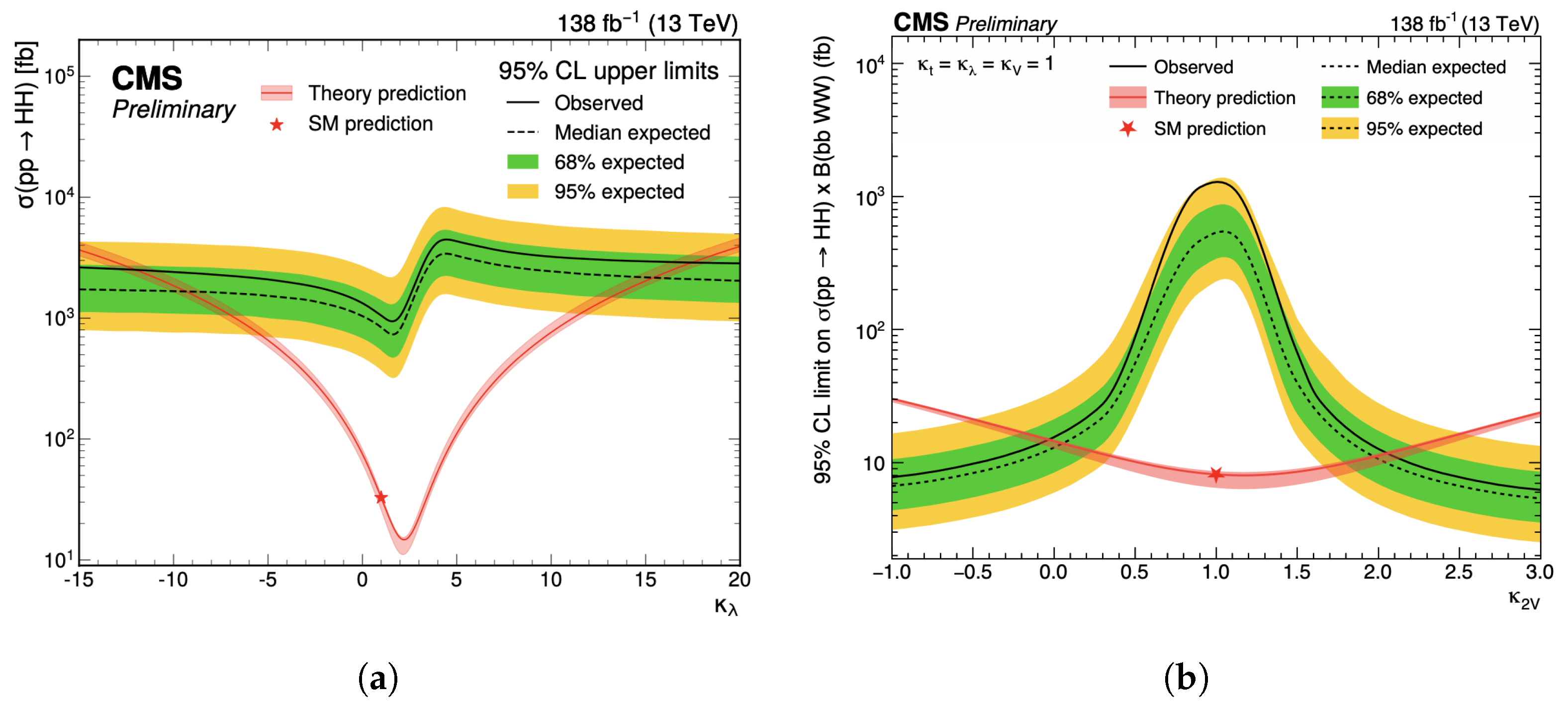Non-Resonant Di-Higgs Searches at the Large Hadron Collider with the CMS Experiment †
Abstract
1. Introduction
2. The CMS Detector
3. Di-Higgs Searches
3.1. Key Non-Resonant Channels
- HH→4b channel: This channel, where both Higgs bosons decay to bottom quarks, has a large branching ratio of 33%. However, it is limited by significant background interference from multi-jet and processes. Advanced techniques such as DeepJet [10] b-tagging and fitting methods allowed one to reduce the background and place the 95% CL limits on between −2.3 and 9.4 [11], as shown in Figure 2a.
- HH→bb channel: With a smaller branching ratio of 0.26%, this channel benefits from a cleaner signature, thanks to the excellent mass resolution of the diphoton system. Techniques like Deep Neural Networks (DNNs) and Boosted Decision Trees (BDTs) are used to suppress the background. The 95% CL limits for this channel are between −3.3 and 8.5 [12], as shown in Figure 2b.
3.2. Less Sensitive Searches
- HH→ channel: This channel, with a very small branching ratio of 0.027%, combines the clean diphoton signature with the relatively larger branching ratio of Higgs boson to tau decays. Backgrounds are modeled using analytic fits, and a double Crystal Ball function is used to describe the signal. A simultaneous maximum likelihood fit is performed on the distributions in the analysis categories. The observed 95% CL constraints on exclude values outside the interval , as shown in Figure 3a. These results are complementary to those found in alternative final states, such as the search with two bottom quarks and two photons, where the observed upper limit was 7.7 times the SM prediction. The inclusion of the channel further strengthens the overall search sensitivity and provides valuable constraints in combination with other final states studied by CMS [14].
- HH→bbVV channel: Involving the decay of one Higgs to bottom quarks and the other to vector bosons, this channel benefits from a branching ratio of 13%. Despite challenges from QCD multi-jet background processes, the use of novel event classification methods, such as the Particle Transformer [15], provides promising limits on the parameter. Specifically, the analysis utilizes a binned maximum likelihood fit to the observed distributions, performed simultaneously in both the signal and background dominated regions. The signal shapes are interpolated using a linear combination of simulations with varying couplings, allowing one to constrain the parameter more precisely. These results show that the coupling modifier is constrained within the ranges at 95% CL, as shown in Figure 3b. This focus on , rather than , arises because this channel is more sensitive to the vector boson–Higgs coupling, which is modulated by , making it a key parameter to probe in the context of this analysis [16].
3.3. Run 2 Combined Results
4. Discussion
5. Conclusions
Funding
Data Availability Statement
Conflicts of Interest
References
- CMS Collaboration. Observation of a new boson at a mass of 125 GeV with the CMS experiment at the LHC. Phys. Lett. B 2012, 716, 30–61. [Google Scholar] [CrossRef]
- ATLAS Collaboration. Observation of a new particle in the search for the Standard Model Higgs boson with the ATLAS detector at the LHC. Phys. Lett. B 2012, 716, 1–29. [Google Scholar] [CrossRef]
- Higgs, P. Broken symmetries and the masses of gauge bosons. Phys. Lett. 1964, 12, 132–133. [Google Scholar] [CrossRef]
- CMS Collaboration. The CMS detector at the CERN LHC. J. Instrum. 2008, 3, S08004. [Google Scholar] [CrossRef]
- Alwall, J.; Herquet, M.; Maltoni, F.; Mattelaer, O.; Stelzer, T. MadGraph 5: Going Beyond. J. High Energy Phys. 2011, 06, 128. [Google Scholar] [CrossRef]
- Nason, P. A New Method for Combining NLO QCD with Parton Shower Simulations. J. High Energ. Phys. 2004, 11, 040. [Google Scholar] [CrossRef]
- Sjostrand, T.; Mrenna, S.; Skands, P. PYTHIA 8: A new generation of event generators. Comput. Phys. Commun. 2008, 178, 852–867. [Google Scholar] [CrossRef]
- Agostinellietal, S. GEANT4: A simulation toolkit. Nucl. Instrum. Methods Phys. Res. A 2003, 506, 250–303. [Google Scholar] [CrossRef]
- CMS Collaboration. Particle Flow Reconstruction and Calorimeter Performance in the CMS Experiment. J. Instrum. 2017, 12, P10003. [Google Scholar] [CrossRef]
- CMS Collaboration. DeepJet: A deep learning approach to b tagging at the LHC. J. Instrum. 2019, 14, P08007. [Google Scholar] [CrossRef]
- CMS Collaboration. Search for Higgs Boson Pair Production in the Four b Quark Final State in Proton-Proton Collisions at s=13TeV. Phys. Rev. Lett. 2022, 129, 081802. [Google Scholar] [CrossRef] [PubMed]
- CMS Collaboration. Search for nonresonant Higgs boson pair production in final states with two bottom quarks and two photons in proton-proton collisions at s=13 TeV. J. High Energ. Phys. 2021, 257, 257. [Google Scholar] [CrossRef]
- CMS Collaboration. Search for nonresonant Higgs boson pair production in final state with two bottom quarks and two tau leptons in proton-proton collisions at s = 13 TeV. Phys. Lett. B 2023, 842, 137531. [Google Scholar] [CrossRef]
- CMS Collaboration. Search for the Nonresonant and Resonant Production of a Higgs Boson in Association with an Additional Scalar Boson in the γγττ Final State; Technical Report; CERN: Geneva, Switzerland, 2024. [Google Scholar]
- CMS Collaboration. Particle Transformer: A Deep Learning Approach for Particle Reconstruction at the LHC. J. High Energ. Phys. 2021, 11, 205. [Google Scholar] [CrossRef]
- CMS Collaboration. Search for Highly Energetic Double Higgs Boson Production in the Two Bottom Quark and Two Vector Boson All-Hadronic Final State; Technical Report; CERN: Geneva, Switzerland, 2024. [Google Scholar]
- CMS Collaboration. A portrait of the Higgs boson by the CMS experiment ten years after the discovery. Nature 2022, 607, 60–68. [Google Scholar] [CrossRef] [PubMed]
- CMS Collaboration. Constraints on the Higgs Boson Self-Coupling with Combination of Single and Double Higgs Boson Production; Technical Report; CERN: Geneva, Switzerland, 2023. [Google Scholar]
- CMS Collaboration. Novel Strategy Targeting HH and HHH Production at High Level Trigger in Run 3; CERN: Geneva, Switzerland, 2023. [Google Scholar]
- CMS Collaboration. DeepTau: A Deep Learning Approach to Hadronic Tau Identification at the LHC. J. Instrum. 2019, 14, P06023. [Google Scholar] [CrossRef]



Disclaimer/Publisher’s Note: The statements, opinions and data contained in all publications are solely those of the individual author(s) and contributor(s) and not of MDPI and/or the editor(s). MDPI and/or the editor(s) disclaim responsibility for any injury to people or property resulting from any ideas, methods, instructions or products referred to in the content. |
© 2025 by the author. Licensee MDPI, Basel, Switzerland. This article is an open access article distributed under the terms and conditions of the Creative Commons Attribution (CC BY) license (https://creativecommons.org/licenses/by/4.0/).
Share and Cite
Palluotto, S., on behalf of the CMS Collaboration. Non-Resonant Di-Higgs Searches at the Large Hadron Collider with the CMS Experiment. Particles 2025, 8, 31. https://doi.org/10.3390/particles8010031
Palluotto S on behalf of the CMS Collaboration. Non-Resonant Di-Higgs Searches at the Large Hadron Collider with the CMS Experiment. Particles. 2025; 8(1):31. https://doi.org/10.3390/particles8010031
Chicago/Turabian StylePalluotto, Simona on behalf of the CMS Collaboration. 2025. "Non-Resonant Di-Higgs Searches at the Large Hadron Collider with the CMS Experiment" Particles 8, no. 1: 31. https://doi.org/10.3390/particles8010031
APA StylePalluotto, S., on behalf of the CMS Collaboration. (2025). Non-Resonant Di-Higgs Searches at the Large Hadron Collider with the CMS Experiment. Particles, 8(1), 31. https://doi.org/10.3390/particles8010031









